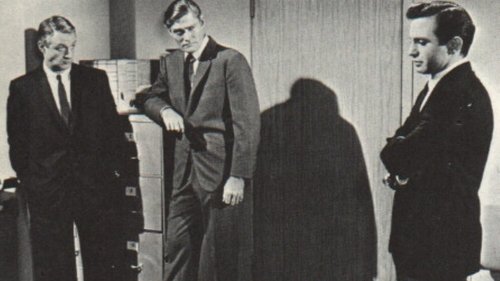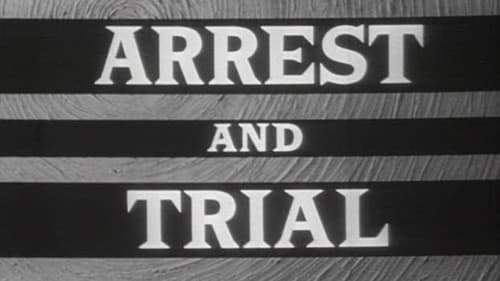Rio Hayward
All of these films share one commonality, that being a kind of emotional center that humanizes a cast of monsters.
Yash Wade
Close shines in drama with strong language, adult themes.
Portia Hilton
Blistering performances.
Stephanie
There is, somehow, an interesting story here, as well as some good acting. There are also some good scenes
runamokprods
Sometimes melodramatic, but intelligent and very well acted early 1960s U.S. TV series, that obviously served as the inspiration for "Law & Order". Like "L & O" this is divided into 2 parts; "Arrest" where cop Ben Gazzara tracks down the person seemingly guilty of that week's crime and "Trial" where Chuck Connors defends them. Having the 2nd half be from the defense point-of-view, not the prosecutor's makes the show different than "Law and Order", and arguably more interesting. It makes blatant how much of the legal system exists in shades of gray. It's not surprising that Ben Gazzara is very, very good as cop Nick Anderson, making him more complex and interesting than your basic TV detective of the era. What caught me off- guard was that Connors as successful attorney John Egan, just about matches him. Unlike Gazzara, Connors was never taken that seriously as an actor,. But he shows a lot here as a top notch, somewhat cynical lawyer. Beyond the two leads, the guest casts were often very strong as well. It's partly because these were 90 minutes episodes on TV, so each show runs about 75 minutes of screen time, as opposed to the standard TV drama that runs an hour, which means about 45-60 minutes of actual story. With the extra time, the writers fleshed out the characters, both regulars and guests, much more fully than on most non-serialized dramas. So even if there are plot or logic holes (like charging a man with 1st degree murder, instead of a much more logical 2nd degree or manslaughter, so the trial can be about the issue of "intent" ) it feels more like you're watching a solid, well acted B-film each episode, instead of an early TV series. And the series has a nice mix of dark edginess and humanism. Yes, the score can be painfully over-the-top, and some of the resolutions are too neat, but I'd still say this holds up favorably to a lot of the modern U.S. character cop and/or lawyer shows of today.
aimless-46
The 30 episodes (all in B&W) of the 90-minute crime drama "Arrest and Trial" originally ran on ABC during its 1963-1964 broadcast season. The new three-disc DVD set includes nine of the episodes: #3, #4, #7, #11 (guest starring Martin Sheen and Michael Parks), # 15 (guest starring Mickey Rooney), #21, #22 (guest starring Nick Adams), #23, #30; seemingly taken at random from the series. The series was an innovative concept as it was essentially broken down by the words in its title. During the first 45 minutes of each episode LA detective Nick Anderson (Ben Gazzara) would solve the crime, arrest the perpetrator(s), and hand them over for trial. The second half concerned defense attorney John Egan's (Chuck Connors) attempts to get them acquitted. That Egan was for the defense and not the prosecution was what made the series unique. Guilt or innocence thus became a relative term. With better writing it could been a great series (think "Hill Street Blues" where the public defender is involved in a romance with the Precinct Captain). Unfortunately rather than actually working in opposition to each other most of the episodes featured little if any interplay between Anderson and Egan. So what you got was more like a 45-minute cop show followed by a 45-minute lawyer show; with the only point in common being the same guest star(s); whose character might just as well have had different names for all it would have mattered. The series tried to hold the cop show fans over for the second half by ingeniously breaking the show at the quarter hour when it was too late to change channels and watch something else. It must not have worked very well because the ratings were too low to support a second season. Gazzara was excellent but Connors was horribly miscast. Most likely someone who is seeing Connors' various shows for the first time is mystified than he got so much television work in 1960's. All I can say is that a lot of people were just as mystified then. Then again, what do I know? I'm only a child.
Ben Burgraff (cariart)
Created by Earl Bellamy, "Arrest and Trial" was an early attempt to meld, a la "Law and Order", the processes of apprehending criminals, then following the legal system as the cases would be resolved. As 'cop' shows and 'lawyer' shows were among television's most popular genres at the time, ABC and Universal thought the program would be a major hit, and provided first-class talent both in front of, and behind the camera.The 'Arrest' phase starred 33-year old Ben Gazzara, a highly respected actor who had made his mark on Broadway in "Cat On a Hot Tin Roof", and in film, in ANATOMY OF A MURDER. Possessing a quick, analytical mind, and a wry sense of humor, Gazzara's 'Nick Anderson' would quickly cut through alibis, and make arrests, aided by fellow detectives Roger Perry ("Harrigan and Son") and Noah Keen ("The Crimebusters").The 'Trial' phase returned TV's "Rifleman", Chuck Connors, to the small screen, as John Egan, an intimidating yet sensitive attorney, and featured veteran actors John Larch (WRITTEN ON THE WIND) and John Kerr (SOUTH PACIFIC) as D.A.s representing the State.While not as intellectual as "The Defenders", "Arrest and Trial" was unique as either side could win or lose a case, as opposed to Perry Mason's nearly flawless record. This was heady stuff for the early sixties!Unfortunately, being on television's 'Number 3' network did the series in, as ABC had a much harder time attracting viewers than CBS and NBC, particularly when the program was promoted as 'quality'.It would take 30 years before "Law and Order" could make the formula work!
schappe1
When Dick Wolf was creating "Law and Order", he was told there had already been a show that followed a crime from it's commission through the investigation the arrest and the subsequent trial. It was called "Arrest and Trial" and was on from 1963-64, a quarter century before the pilot for "Law and Order", (I'll call them A&T and L&O). Wolf screened an episode of A&T and concluded that their show was very different from his. He was right. The biggest difference, however, was not in concept but in time.A&T is a 90 minute show, L&O an hour. L&O is a story-driven show with the nature of it's characters suddenly and starkly revealed. A&T is a character study that shows situations developing over time and their effect on people as they happen. In L&O the cops are cops but the lawyers are prosecutors, attempting to forge justice using the imperfect tool of the law. Their adversaries are usually rather sleazy criminals who cared about no one but themselves and their equally self-interested attorneys, people who care nothing about law or justice but just want to win. In A&T the cops are part psychoanalysts and the criminals victims of tragic circumstances. The lawyers are highly principled defense attorneys. The prosecutor is a very friendly adversary who almost reluctantly does his job, even though he may even be sympathetic toward the accused. L&O is mostly about legal issues as the lawyers dual with each other. Whatever moral issues come up have been violated by the criminals. In A&T, there is always some great moral issue that dominates the question of whether the accused is guilty of the crime. How do we treat the insane? Drug addicts? The emotionally distraught?When I had a chance to view A&T myself after many years of watching L&O, I found it a pleasant surprise, perhaps the most underrated show of my favorite TV decade, the Sixties. The length and emphasis on crime as human tragedy provided some very fine actors such as James Whitmore, Joseph Schildkraut, Mickey Rooney, Roddy McDowell, (who starred in a version of "Crime and Punishment") and many others with tours de force. The writing and acting was very strong. Ben Gazzara, (who I recently spotted in an L&O episode, with his voice apparently dubbed for some reason- I hope he isn't having health problems), played a very thoughtful and sympathetic policeman and Chuck Conners was fine and forceful as an idealistic attorney. It's a consistently entertaining show, one that covers much of the same ground as the excellent "The Defenders" from the same period.But it's clearly a product of it's time. There are no bad guys. The victims are often faceless or minor characters. Prosecutors and defense attorneys are brothers in arms, fighting for what's right. There's never talk of a deal. This was from a time when, in the last generation, we'd survived a depression, won a war, were holding back Communism and reaching for the moon. We were going to get rid of poverty and injustice. A great many shows presented the contemporary world, one with problems but problems which seemed soluble with heroic effort. Dr. Kildare, Mr. Novak, The Defenders, East Side West Side, Naked City, even Route 66. A&T was definitely a product of this environment.L&O is product of a much more cynical age, one where people are grubbing for whatever they can get, protecting their own interests and bending the law anyway they can to get what they want out of it.


